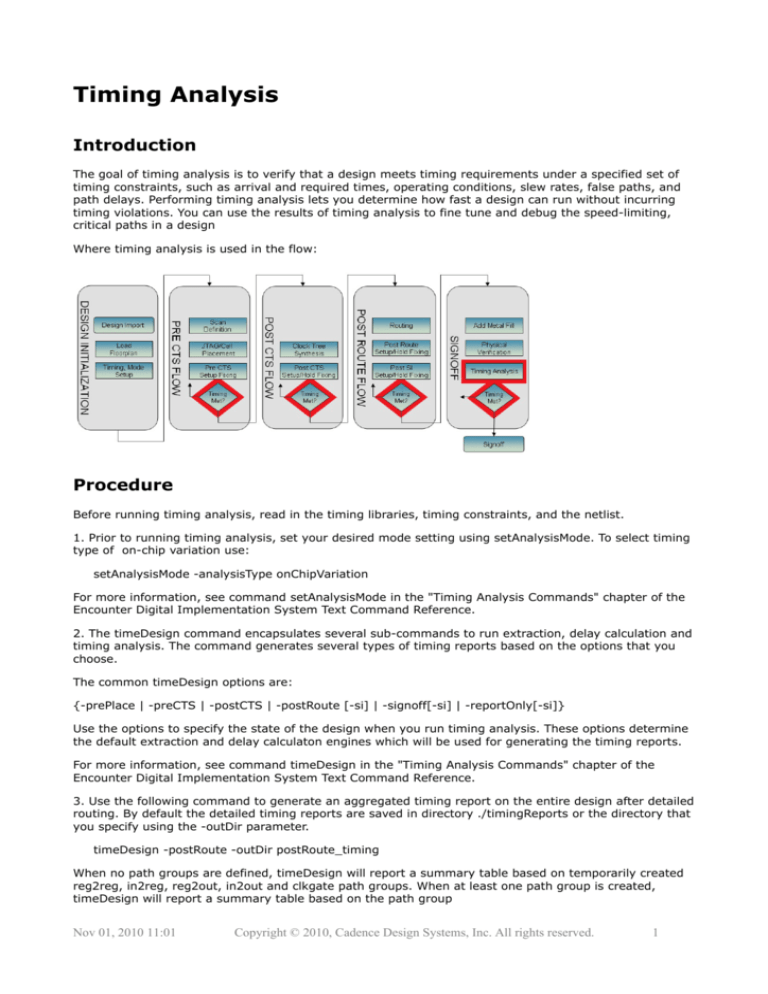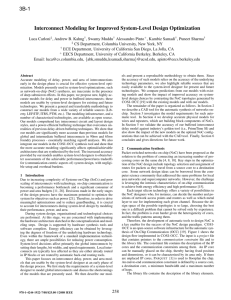
Timing Analysis
Introduction
The goal of timing analysis is to verify that a design meets timing requirements under a specified set of
timing constraints, such as arrival and required times, operating conditions, slew rates, false paths, and
path delays. Performing timing analysis lets you determine how fast a design can run without incurring
timing violations. You can use the results of timing analysis to fine tune and debug the speed-limiting,
critical paths in a design
Where timing analysis is used in the flow:
Procedure
Before running timing analysis, read in the timing libraries, timing constraints, and the netlist.
1. Prior to running timing analysis, set your desired mode setting using setAnalysisMode. To select timing
type of on-chip variation use:
setAnalysisMode -analysisType onChipVariation
For more information, see command setAnalysisMode in the "Timing Analysis Commands" chapter of the
Encounter Digital Implementation System Text Command Reference.
2. The timeDesign command encapsulates several sub-commands to run extraction, delay calculation and
timing analysis. The command generates several types of timing reports based on the options that you
choose.
The common timeDesign options are:
{-prePlace | -preCTS | -postCTS | -postRoute [-si] | -signoff[-si] | -reportOnly[-si]}
Use the options to specify the state of the design when you run timing analysis. These options determine
the default extraction and delay calculaton engines which will be used for generating the timing reports.
For more information, see command timeDesign in the "Timing Analysis Commands" chapter of the
Encounter Digital Implementation System Text Command Reference.
3. Use the following command to generate an aggregated timing report on the entire design after detailed
routing. By default the detailed timing reports are saved in directory ./timingReports or the directory that
you specify using the -outDir parameter.
timeDesign -postRoute -outDir postRoute_timing
When no path groups are defined, timeDesign will report a summary table based on temporarily created
reg2reg, in2reg, reg2out, in2out and clkgate path groups. When at least one path group is created,
timeDesign will report a summary table based on the path group
Nov 01, 2010 11:01
Copyright © 2010, Cadence Design Systems, Inc. All rights reserved.
1
By default, timeDesign reports setup timing. To report hold checks, -hold option needs to be used.
timeDesign -hold
For Multi-Mode Multi-Corner (MMMC) designs, timeDesign reports the timing for each active analysis
view, as well as an aggregated summary.
4. Use command report_timing to generate timing reports on specific paths. You can use the -format
option to customize the report fields
Examples
To generate an aggregated timing report summary prior to CTS, use the following command. This
command runs Trial Route, native default extraction, and timing analysis to generate timing reports
before clock tree synthesis:
timeDesign -preCTS
The following example shows an aggregated summary report generated by timeDesign:
The following command ignores the net load and runs timing analysis before the design is placed.
timeDesign -prePlace
The following commands use native detailed extraction and timing analysis to generate timing reports for
both setup and hold after the design has been routed.
timeDesign -postRoute
timeDesign -postRoute -hold
The following command runs timing analysis for signoff taking into account effects of signal integrity and
using QRC engine for extraction:
timeDesign -signoff -si
Nov 01, 2010 11:01
Copyright © 2010, Cadence Design Systems, Inc. All rights reserved.
2
The following command specifies the use of existing extraction and timing analysis data to generate
timing reports. When you use this parameter, the software does not run extraction or timing analysis;
instead it uses data that is already in memory.
timeDesign -reportOnly
To generate a timing report on the most critical path which traces complete launch and capture clock
paths, run the following command:
report_timing -path_type full_clock
You can use the -format parameter to customize which columns displayed when running command
report_timing. Valid format columns are: adjustment, annotation, arc, arrival, cell, delay, direction,
edge, fanin, fanout, incr_delay, instance, instance_location, load, locv_derate, net, phase, pin, hpin,
pin_location, required, retime_delay, retime_slew, slew, stolen, and user_derate.
To display columns: cell, delay, fanout, instance, load, net and slew, run the following command:
report_timing -format {cell delay fanout instance load net slew}
By default, the following columns are displayed when running report_timing:
{instance arc cell delay arrival required}
Alternatively, you can permanently set the desired columns using :
set_global report_timing_format
This will display the specified columns each time report_timing is called. For example:
set_global report_timing_format {cell delay fanout instance load net slew}
report_timing
Nov 01, 2010 11:01
Copyright © 2010, Cadence Design Systems, Inc. All rights reserved.
3









